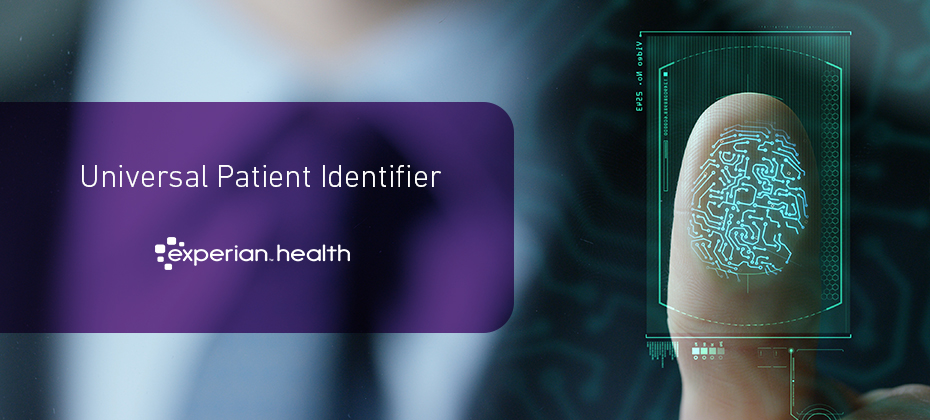Identity Management
Match, manage, and protect patient identities.

"93% of providers say creating a better patient experience remains a top priority, up 3% from last year." - Experian Health's State of Patient Access, June 2021 In November 2020, we surveyed patients and providers for their sentiments on how patient access changed because of the pandemic. During this time, patients welcomed the convenience and control that came with digital, contactless care. Providers knew they needed to improve their digital front door to withstand the financial impact of COVID-19, but implementation was difficult for many organizations. Six months on, and millions of immunized Americans later, the pandemic landscape shifted again. In June 2021, we revisited these questions to find out if patient and provider views have changed - in our State of Patient Access 2.0. Now, patients tell us they feel more confident about returning to facilities, though they still want the flexibility and convenience of digital scheduling, registration, and payment options. Providers feel a growing urgency to make sure online services are sufficiently agile enough to withstand any future surges in COVID-19 case numbers. The findings of the survey reveal four major opportunities to rethink how we “do” healthcare. By innovating and building on the digital advances made possible during the pandemic, providers can create better patient access experiences for the future. To start, providers should: 1. Match consumer expectations for convenient and flexible patient access Our recent survey shows that the pandemic has cemented consumer expectations around convenient access to care. Digital and remote channels for scheduling appointments, completing pre-registration, and making payments have become the new baseline in patient access. Nearly three quarters of patients told us they want to schedule their own appointments online. Providers know this: 93% say creating a better patient experience remains a top priority, up 3% from last year. Online self-scheduling can help providers continue to meet their patients’ demands for flexibility and convenient access to care. Patients can find, book and cancel appointments whenever and wherever they prefer. It’s also a win for providers, who can expect to see a drop in administration errors, no-shows, and denied claims. 2. Streamline prior authorizations as more patients return to care Interestingly, new data reveals that patients are less anxious about in-person care. In 2020, 40% of patients were uncomfortable coming into waiting rooms and seeing their doctor in person. Now, only 16% say they wouldn’t be comfortable in a waiting room. As more patients rush to reschedule deferred care, providers are faced with the challenging combination of higher patient volumes, patients jumping health plans as a result of job losses, and changing payer rules around prior authorizations and coverage checks. Automated pre-authorization and automated coverage checks can relieve the pressure, and help providers save time and resources. 3. Promote price transparency for fewer missed payments An encouraging piece of insight from our latest survey reveals that far fewer patients say they’ve been surprised by their final medical bill. In 2020, more than 50% received a final figure that differed significantly from estimates. Six months later, that figure has dropped to just 14%. Price transparency remains important, and the gap between estimated and final costs seems to be closing. More providers are offering patient billing estimates, with 9 in 10 agreeing that accurate estimates increase the chance of bills being paid on time. Many are also giving patients more options to pay bills earlier in the journey, which has helped to minimize the risk of late and missed payments. Easy and accessible digital options are featured heavily in acquisition and retention plans, and can help drive financial recovery. 4. Tighten up data strategies with better security, quality and insights While our first survey revealed that the sudden shift to digital-first patient access was a shock to the system for many providers, the second study shows that both patients and providers are settling into digital ways of working. But as these digital services become the new baseline, providers must make sure their data strategies are fit for purpose, and prioritize data security, quality and insights. Moving forward, a multi-layered approach will help providers authenticate and secure patient identities. When these identities are enriched with information about how patients are affected by the social determinants of health, providers will be better positioned to offer personalized patient access experiences and support marginalized groups. The future of healthcare is digital. Is your organization prepared? It’s clear from our recent survey that the digital trends that emerged in 2020 are set to continue throughout 2021 and beyond. Download the State of Patient Access 2.0 white paper to get the full survey results and explore how data and digitalization can power a 24/7 patient access experience in your healthcare organization.

“Experian Health’s speed and ability to speak our business language definitely impressed us,” said ACS president, Tim Anderson. “Some of the claims were valid for only a few more weeks, and we were able to submit them in plenty of time. This is the best, fastest platform we’ve seen to reconcile duplicate and data-deficient records. It really helped us achieve the best possible resolution for our clients and our company.” Acadiana Computer Systems, Inc. (ACS) was contracted with numerous labs in Louisiana to submit billing claims, primarily to Medicare, for testing that occurred in the first months of the pandemic. Unfortunately, in the chaos and scramble to offer testing services as quickly as possible in nursing homes and testing sites, the labs struggled to collect needed information to submit valid claims – in particular the Medicare beneficiary’s MBI number, or even a Social Security number. As the pandemic response progressed, a similar challenge developed around the administration of vaccines, particularly in mass vaccination sites and other off-site vaccination centers. Providers struggled to get more than a name and maybe a birthdate, address, or phone number. This left a gap in ACS’ efforts to submit private insurance and Medicare reimbursement claims on behalf of their clients. ACS worked with Experian Health and our Universal Identity Manager (UIM) platform, delivering the Experian Single Best Record (ESBR) – the matching of records through aggregation of disparate information and delivering a single record that accurately identifies separate records that belong to one person. The platform uses multiple data sources to verify, match and consolidate disparate records into one “best record.” ACS assembled the records requiring more identifying data and prepared them for secure transfer to Experian Health. Experian Health securely accepted more than 75,000 patient records and ran them through the UIM platform in 24 hours. It was critical to assign an SSN to as many individual records as possible, and to confirm an associated MBI number for Medicare billing, if applicable. Results included: 69% assigned unique records 12% identified as duplicate records With the information delivered back from the matched records, ACS had all the necessary data needed to continue the billing process. Within a week claims were submitted, expected to exceed $20 million in collections when the process is completed. The ACS group was experienced, savvy and data ready. Their expertise enabled an elegant and efficient exchange and complemented Experian Health’s capabilities. ACS expects to continue to use Experian Health’s UIM platform throughout the pandemic and also for mitigating duplicate records and preparing claims for submission. Learn more about how our Universal Identity Manager (UIM) platform can help your organization eliminate duplicate patient records.

Knowing that clinical care accounts for only a portion of health outcomes, understanding how patients are affected by social determinants of health (SDOH) continues to gain attention as a critical factor in care delivery. COVID-19 has thrust the issue even further into the spotlight, with socially and economically vulnerable groups hardest hit by the pandemic. At the same time, the expansion of telehealth services over the last year has benefited some marginalized groups, who may feel uncomfortable visiting health facilities or may, for example, sometimes face challenges finding transportation to and from their visits. What’s clear is that when it comes to mitigating the impact of COVID-19’s lingering effects, patient identities based on clinical data alone simply won’t cut it. Providers need a holistic view of patients – both clinical and non-clinical. Many providers do not have updated contact information for the patients they want to engage, in addition to missing patient-level insights such as housing, food, access to technology, transportation and financial stability data that could help better engage patients. Given the many complicated personal and structural barriers that may exist to accessing healthcare, providers lacking SDOH data in patients’ records are risking avoidable readmissions, unnecessary ED visits, poor care quality ratings and denied reimbursements. Understanding patient needs and preferences via lifestyle factors – like occupation and technological knowledge – helps providers improve engagement, outreach and access. The results can be game-changing. The benefits of an enriched, more robust patient record with SDOH Improved certainty of patient needs to achieve healthy outcomes Whether it’s missed appointments, lack of engagement, deferred treatment, or failure to comply with care instructions – if SDOH is the cause, providers need to know. An enriched patient record that includes clearly defined SDOH risks and insights to those risks is invaluable. For example, if a patient record includes recommended engagement strategies suggesting medication delivery, or ensuring medications are with the patient at discharge, due to the patient’s difficulty accessing a pharmacy, negative outcome risk is reduced. Significant provider blind spots that might otherwise interfere with desired health outcomes can be eliminated or extensively mitigated with access to this kind of data. Consumer data gives additional insight useful in risk stratification efforts, allowing care teams to get granular and proactive if, for example, a patient’s lifestyle makes office-hour calls impossible, or if a lack of transportation requires the patient be informed that telehealth is available. Additionally, the data can flag if the patient prefers reminders by text, voice message or email. These considerations make a difference; 80-90% of modifiable contributors to healthy outcomes for a population are regularly attributed to the social, economic and environmental factors that comprise SDOH. Connecting the dots can improve care coordination SDOH data doesn’t just help flag general access issues; it can also help providers dig into specific challenges that may warrant referrals to community programs or additional staffing support. SDOH data may lead to the discovery that a patient is struggling to access healthy, affordable food and prompt a conversation about getting referred to an in-network nutritionist or local food partnership. Patient-specific information can be merged with consumer databases covering a range of socio-economic data, initiating proactive conversations with patients that can solve non-clinical gaps in care. Clarity of the “why” behind patient insights, for better communication and engagement Someone experiencing financial instability as a result of pandemic-related unemployment will expect a different financial conversation than someone who has lived in poverty for their whole life. Further, two patients with high readmission risk can have completely different social determinants of health impacting that risk. Knowing that patients are affected by SDOH is only one piece of the puzzle. Understanding the bigger picture helps create a whole picture and enables personalized, sensitive, and helpful communication. A turn-key SDOH solution that helps define the “why” behind the score avoids analysis paralysis and enables a quick, effective engagement strategy based on what really matters to patients. Supplementing patient surveys with consumer data is also important, as it provides deeper insights and recommendations for engagement strategies. Of course, a connected system only works when the patient identity is accurate and tracks them from service to service. With a universal identity manager, you can have confidence that your teams are all working from a complete, current and insights-rich view of each patient. Find out more about how Experian Health can help your organization make sense of SDOH data for better patient identity management and a more personalized patient experience.

Many thought the end of COVID-19 was in sight with the availability of a vaccine, and while that is somewhat true, an entirely new set of issues has arrived: how to properly administer and manage the vaccine. Now that a COVID-19 vaccine is approved and underway, providers need to execute a medical billing and coding strategy to sustain vaccination efforts. We interviewed J. Scott Milne, senior director of product management at Experian Health, about what’s changed and what providers can do to prepare. How can providers ensure that vaccine administration codes are billed correctly? The ICD-10 and CPT codes for the COVID-19 vaccine haven’t existed until now, which means providers have a new set of codes to learn and unfortunately, those codes seem to change or update almost daily. As more vaccines are introduced, more codes are also introduced, and not just for the vaccine as a whole, but for each specific dose of the vaccine. For example, dose one of the Pfizer vaccine will have a code that differs entirely from dose two of the Moderna vaccine. Keeping up with these changes isn’t only difficult for provider staff, who are likely already stretched thin, but they certainly don’t want to run the risk of submitting a claim with incorrect information. The errors are what result in denials or undercharges. A solution like Claim Scrubber ensures code sets are current on a daily basis – a necessity for times like these – but applies an extensive set of general and payer-specific edits before preparing the claim for processing. That means claims for vaccine administration are error-free before submission to the payer or clearinghouse. Providers can eliminate undercharges, boost first-time pass through rates and do away with costly, time-consuming rework. But proper coding is only the first piece of the billing puzzle. The second piece is to verify the accuracy of payment received from third-party payers. How can providers ensure that third party payers will reimburse at the contracted rates? Providers can certainly get reimbursed for administering the vaccine, but there are a lot of moving parts to keep up with. For example, both Medicaid and Medicare will reimburse providers for administering COVID-19 vaccines, but the percentage of what is covered will differ by carrier and the reimbursement rates can vary both by state and type of arrangement. Reimbursement rates will also vary amongst private payers. Then there is the variation in reimbursement based on vaccine type and dosage -- vaccines that require a single dose may be reimbursed at a rate different than those that require two doses. Even without the vaccine rollout underway it can be a headache for hospitals and health systems to manage multiple payer contracts and reimbursement methodologies. A solution like Contract Manager will pinpoint variance in reimbursement quickly and easily, accurately pricing claims and comparing actual allowed amounts to expected amounts. It is a tool built to adapt to changes within the industry, so providers can capitalize on emerging reimbursement schemes and changes in payer payment policies. It can also help identify sources and patterns of errors so recurring issues can be promptly resolved. The end result: the provider organization can the payer revenue that is due for vaccine administration. Interested in learning more about how providers can optimize vaccine-related reimbursements? Other blog posts in this series: Segmenting your patient population for the COVID-19 vaccine Engaging patient segments with convenient, secure scheduling solutions Authenticating portal access with automation Optimizing reimbursements by capturing missing coverage

Other blog posts in this series: Segmenting your patient population for the COVID-19 vaccine Engaging patient segments with convenient, secure scheduling solutions The patient portal can play an important role in COVID-19 vaccination efforts, allowing patients the ability to both schedule their vaccines and keep track of where they are in the process, at least for those vaccines that require more than one dose. We interviewed Victoria Dames, senior director of product management at Experian Health, about how providers can authenticate portal access with automation, while also protecting patient identities. As portal traffic increases, what are the authorization concerns? Many providers who are supporting the mass vaccination sites are leveraging their existing patient portals to schedule patients for the vaccine. As providers are now seeing individuals sign up for portals at scale it can difficult to ensure that the individuals being granted access to the portal are in fact who they say they are. That is a huge concern knowing the patient portal contains PHI that is commonly a target for fraudsters. What are the benefits of automating portal enrollment and access? Automation alleviates two things. First, it provides an industry-wide level of security and assurance. It provides the market standard for identity proofing before granting access to a patient record. Second, it alleviates a lot of the administrative burden put on provider staff. Automating portal enrollment allows staff to focus their attention on other, more important efforts. And, for portal enrollment at this magnitude, automation really is necessary. Providers are seeing individuals going back multiple times to the same portal, signing in more than once and sometimes with multiple log-ins, just to schedule an appointment for a vaccination. Our recent survey on patient access found that 54% of patients are concerned about security when accessing their personal details online. From a provider’s perspective, does having a system like this help with the objective of making patients feel more secure? One area where patient and provider views align is around the security of digital access solutions. The balance, though, between security and convenience can be a tough one to maintain. Moving quickly while maintaining security – and without adding undue friction – is a tall order, but it’s not optional. With the right tools and support, providers can safeguard patient data throughout the vaccination process with confidence and make the portal enrollment process as frictionless as possible. Interested in learning more about how Experian Health can help supercharge the COVID-19 vaccine management process?

Providers know they need to improve their digital front door to withstand the financial impact of COVID-19, but change can feel risky, especially with so much uncertainty. Experian Health’s recent patient access survey offers a glimpse of what patients hope the digital front door will look like in 2021 and beyond. But what do providers see for the future of patient access? And are those views aligned? Providers that offer the most accessible patient access solutions in a post-pandemic world will secure greater patient satisfaction and loyalty.

The urgency to move quickly and vaccinate the population has introduced an entirely new set of challenges for providers regarding patient identity. Many continue to leverage existing processes and solutions already in place, manually handling the pain points that come with them, but now at scale and at an unprecedented rate. As the rollout moves forward, the strain on provider resources will only deepen, as will the risks associated with patient misidentification. The data mess behind the scenes Many patients are registering for the vaccine through a patient portal. While the self-service nature of signing up for the vaccine via a portal is beneficial, patients are unfortunately able to register for a portal account more than once. In fact, some of our clients have reported seeing as many as 1,800 duplicate records created per day. Those duplicate records are generated from some individuals who forgot their log-in account information and opted to create a new account, and others who simply forgot they had an account. With the sense of urgency to secure a vaccination appointment, consumers are moving at a rapid speed and simply want to grab a spot with the quickest credentials available. Regardless, multiple registrations for a single patient will create duplicate patient information. Duplicate records are not only costly (the estimated cost of remediation is $96 per duplicate pair), but they are an incredible drain on staff productivity, and ultimately, they are detrimental to patient safety. Multiple records of a single individual pose a risk for potential allergies, reactions, medical history and more. Even more, it is detrimental specifically to the efficacy of the vaccine as it will be harder to gauge in real time how many patients have been vaccinated, and at what stage, and make it more difficult to truly understand what percentage of the patient population has actually been vaccinated. UIM: not another stop-gap solution Experian’s Universal Identity Manager (UIM) platform is tailor-made for a situation like this as it was developed to create a single view of the same patient with their most current information. The matching technology accurately identifies patients and matches records within and across disparate healthcare organizations, providing a more complete understanding of who a patient is, despite the data gaps or errors that may exist in patient rosters. With it, providers are not only preventing duplicate and overlaid patient records but UIM can also minimize errors and fraud in patient records. It additionally improves staff productivity by decreasing the need for record reconciliation—a benefit likely welcomed by many if they are continuing to see anywhere near 1,800 duplicate records per day. When integrated with a solution like Precise ID, providers can both reconcile duplicate records, and effectively stop them from being created in the first place. By automating the patient portal enrollment process, healthcare organizations can remove the manual processes associated with portal enrollment, optimize critical IT staff resources while securing patient information and support a positive patient experience. State-of-the-art identity proofing, risk-based authentication and knowledge-based questions help providers securely verify each patient’s identity as they enroll for the patient portal. Explore how Experian Health can help resolve and enhance identities as part of the vaccine management process and beyond, not only by resolving duplicate records, but also by enhancing records with the best demographic and social determinants of health data available.

How has the pandemic affected consumer attitudes around patient access? What do consumers want when it comes to accessing care? These are the questions providers must answer if they are to survive the pandemic and lay the groundwork for future financial success. Experian Health’s recent patient access survey offers a glimpse of what patients hope the digital front door will look like in 2021 and beyond. Wherever you are in the digital patient access journey, there's an opportunity to improve the experience for patients to one that will not only survive the tumult of the pandemic, but also thrive in the years ahead.

Editor's note: This blog post was updated on October 2, 2023. In today's rapidly evolving healthcare landscape, the need for a standardized approach to patient matching and identification has become crucial. Not having a unique patient identifier (UPI) not only poses challenges to managing patient data but also hampers interoperability between healthcare organizations. A unique patient identifier (UPI) is a method for standardizing patient identification. Individuals are assigned a unique code, and that code, rather than a Social Security Number, name, or address, is what is used by healthcare organizations to identify and manage patient information. A standardized code like this not only protects sensitive health information but supports the exchange of data between healthcare organizations and states as it is a number and format easily read and recognized by all. Advocates for a coordinated approach to patient matching are continuing to make the case for a national unique patient identifier (UPI). In April 2023, healthcare organizations wrote to legislators urging them to reject language in the 2024 Health and Human Services appropriations bill that prohibits the use of federal funding for a national UPI standard. More than 150 healthcare and medical organizations signed the letter, including Experian Health. The coalition argues that a standardized approach to patient matching could save lives, avoid medical errors, reduce unnecessary costs and greatly improve operational efficiency. While federal funding currently remains off-limits, the industry is poised to move forward to develop a national patient identity solution that is cost-effective, scalable, secure and one that protects patient privacy. Let's explore how a UPI can revolutionize the healthcare industry and create a truly connected ecosystem. How a unique patient identifier is used in healthcare UPIs give providers and payers a way to link records for the same patient or member, so they have one complete record. Without a UPI, a provider may inadvertently create a duplicate patient record because a slight variation in the patient's name or address means their original record isn't accurately matched to them. A 2022 survey by Patient ID Now found that 6 in 10 healthcare organizations had estimated duplication rates of 4-8%, while 16% of organizations had more than 15 patients with the same name. If there's more than one record for a patient, providers may miss important medical information that's not carried through to the version of the record they're looking at. Unreliable records can also lead to misidentification, where patients with a similar name may have their records incorrectly matched. According to the ECRI Institute, misidentification is one of the top ten threats to patient safety. Patients could be given the wrong treatment or medication, with life-altering or fatal consequences. While patient safety is the top concern for providers, efficiency is another driver of attempts to improve records management. Organizations report spending $1.3 million per year on patient identity resolution, as resources must be redirected to figuring out who patients are and fixing errors. Being able to correctly link records for a complete view of an individual's identity can help circumvent these challenges. A unique patient identifier is the key to interoperability Managing patient data across the entire healthcare ecosystem is a long-standing challenge. Many organizations rely on master patient indexes to match patients using demographic data. But these single-source databases are rife with gaps, overlaps, and outdated patient information. They can't keep up with simple name and address changes or easily identify and fix data entry errors. A more effective solution involves combining data sets to create complete identities and profiles, where every piece of new data is instantly updated and verified. Experian Health uses referential matching technology to achieve a fuller picture of each patient's identity. The UPI then acts as a golden thread, linking each patient record correctly within and between systems. For example, if a provider has a patient in their EHR twice under two spellings of the patient's name, a UPI would link those two profiles, creating a singular view of the patient. If a pharmacy has a patient listed under a birth name but the doctor has them listed under their married name, a UPI can ensure both systems match the patient correctly. When combined with other patient engagement solutions, data and identity management tools create the infrastructure needed for healthcare to truly become one cohesive, patient- and member-centric network. It is important to note that the UPI is not a patient-facing number and is not known to the patient or provider. It does not collect or share any clinical claims or diagnostic information; its purpose is simply to link records together giving providers and payers a complete view of someone's identity. Improving the patient experience with a unique patient identifier Healthcare consumers are increasingly seeking digital-first, efficient processes, and they're sensitive to the need for robust data security. Healthcare organizations must demonstrate their ability to manage patient data properly from the patient's first interaction. If data management is inefficient, patients will find themselves being forced to fill out forms they've already filled out multiple times or undergo duplicate tests as they travel between facilities. Patients with similar names may be confused if they're shown someone else's details during the identification process. In an ecosystem built around a strong healthcare network, these discrepancies can be avoided. The patient's unique identifier remains consistent across every healthcare facility they visit – including physicians' offices, hospitals, pharmacies, specialists and long-term care facilities – so all providers know exactly who they are. While patients welcome a more convenient, coordinated experience, they'll also be reassured by the reduced risk of medical errors that comes with a well-connected healthcare network. Efforts to improve patient identity resolution in healthcare While there may not be a national UPI yet, the industry is trying to find workaround solutions. The Centers for Medicare & Medicaid replaced Social Security Numbers with Medicare Beneficiary Numbers as the primary means of identifying Medicare beneficiaries. But while this addresses the risk of data breaches, it doesn't resolve the interoperability challenge. Another initiative is Project US@ (Project USA), run by the Office of the National Coordinator for Health Information Technology (ONC). This aims to create a consistent healthcare industry-wide specification for representing patient addresses, to improve address accuracy. This would ensure that, for example, the same street name written as “road” and “Rd.” is not mistakenly viewed as two different addresses by the software. To support efforts to integrate disparate software solutions, Experian Health announced in 2019 that every person in the United States had successfully been assigned a unique UPI, powered by Experian Health Universal Identity Manager (UIM) and NCPDP Standards™ (the “UPI”). Combining Experian's expansive data assets and innovative UIM technology along with NCPDP standards, each person who has received medical care or used a pharmacy has been assigned a UPI. As new patients enter the healthcare ecosystem, this number will continue to grow. Dave Roberts, VP of Platform Products at Experian Health, says that “the technological foundation is already in place for data interoperability through the creation of UPIs that are maintained in a master person index. These solutions are vendor-neutral, meaning data can flow freely between disparate electronic health systems, regardless of size or location.” Utilizing Experian Health's Patient Identity Solutions The implementation of unique patient identifiers holds immense potential for creating a connected healthcare ecosystem. By standardizing patient identification and enhancing data management, a unique patient identifier can improve patient safety, reduce costs, and streamline processes across the entire healthcare industry. Find out more about how Experian Health's patient identity solutions serve as stepping stones towards a more efficient and patient-centric healthcare network.
